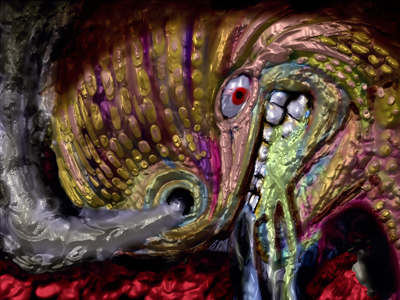Common sense in Art of reality and digital space
Traditional painting
+
Traditional painting offers the ability to do something infinite in size. The color is also relative to real world light, so the colors you see in your creation are never the same to your eyes. A real life image is more effective during the day, because of it’s dependancy on the suns constant radiance.
A large piece would take more materials because you can not scale a stroke or continuously apply color in reality without wasting something. To undo something in reality, you must also waste materials. Unless you wanted to redo the whole image with a different hue by using the same amount of materials and time, you’re stuck with what you have done. Any readjustment will deter the image from what it originally was, due to your human touch. Zooming in and out involves the distance between your eyes and the canvas. It is great to be able to produce an infinitely large image, but if you have to walk away from it and see the whole thing from a distance; you are disabling yourself from being able to draw with that proper perception. It is difficult to maintain perspective if you are working on a wallsize image.
Digital Painting
+
Digital painting offers many freedoms in error correction and readjustment. Your color palette can be absolutely controlled. Your materials are infinite. No cleanup of materials are involved. You can change the color of a finished project infinitely without deterring it’s original concept. It is possible to zoom in beyond natural vision to edit pixels/pixols.
Depending on complexity of color arrangement and image size, your system will become sluggish, and your brush will not react as fast as your hand movement. Since you can’t create an infinitely large image due to your limit of computer memory(CM) and speed of processor (CPU), images can only be created at most 4096x4096 resolution(approximately 3’x4’ printsize) while maintaining the ability to at least draw with a sluggish brush. A print is not even half as rich as the drawing you created. An unprinted digital image’s color is absolute, since it is projected off a screen that gives light. It is deterred by the light of the sun instead of being improved upon.
Traditional sculpting
All the principles in painting can be applied to sculpting. Sculpting however, deals with adding and/or subtracting from a three dimensional canvas.
Besides basic clay characters, sculptures are not usually animated. Weight issues restrict from being able to build with absolute freedom in composition, and must be distributed based on real world calculations. Erosion is noticable on older sculptures. You only have one chance to do subtraction modeling(wood carving). When choosing a medium, in most cases you are stuck with that medium and will not be able to turn a marble carve into wood.
Digital Sculpting
+
Digital sculpting is a very unique blend of mathematics and art. It is possible to animate any object created. There is no need to worry about weight. Modeling in symmetry allows quick sculpting of an identical side. You can scale to any virtual size. No matter what is being done, it is possible to add or subtract from the object at any time. It is easy to convert a sculpted objects surface to look like any material, such as wood, clay, metal, etc.
All sculpts are most likely to be based on square/triangular polygons. Since digital sculpting is heavily dependent on underlying surface, your objects will not be able to shape properly without planning. Proper arrangements of these polygons is key when defining your initial shape. In order to smooth an object, you must cut each visible polygon into four pieces(assuming they are 4 point polys). Each time you smooth , you have less control over your base shape, and your computer also becomes more sluggish. A digital model can never be physical. At best, it can only be a print in reality.


